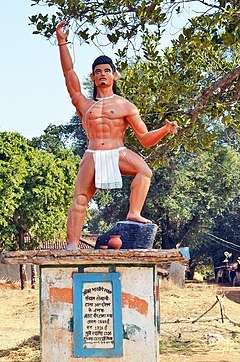
Mohandas Karamchand Gandhi was an Indian lawyer, anti-colonial nationalist, and political ethicist who employed nonviolent resistance to lead the successful campaign for India's independence from British rule. He inspired movements for civil rights and freedom across the world. The honorific Mahātmā, first applied to him in South Africa in 1914, is now used throughout the world.

The Indian Independence Movement was a series of historic events in South Asia with the ultimate aim of ending British colonial rule. It lasted until 1947, when the Indian Independence Act 1947 was passed.

Satyāgraha, or "holding firmly to truth", or "truth force", is a particular form of nonviolent resistance or civil resistance. Someone who practises satyagraha is a satyagrahi.

The non-cooperation movement was a political campaign launched on January 4, 1921 by Mahatma Gandhi to have Indians revoke their cooperation from the British government, with the aim of persuading them to grant self-governance.

The Salt march, also known as the Salt Satyagraha, Dandi March, and the Dandi Satyagraha, was an act of nonviolent civil disobedience in colonial India, led by Mahatma Gandhi. The 24-day march lasted from 12 March 1930 to 6 April 1930 as a direct action campaign of tax resistance and nonviolent protest against the British salt monopoly. Another reason for this march was that the Civil Disobedience Movement needed a strong inauguration that would inspire more people to follow Gandhi's example. Gandhi started this march with 78 of his trusted volunteers. The march spanned 387 kilometres (240 mi), from Sabarmati Ashram to Dandi, which was called Navsari at that time. Growing numbers of Indians joined them along the way. When Gandhi broke the British Raj salt laws at 8:30 am on 6 April 1930, it sparked large-scale acts of civil disobedience against the salt laws by millions of Indians.

The Anarchical and Revolutionary Crimes Act of 1919, popularly known as the Rowlatt Act, was a law, applied during the British India period. It was a legislative council act passed by the Imperial Legislative Council in Delhi on 18 March 1919, indefinitely extending the emergency measures of preventive indefinite detention, imprisonment without trial and judicial review enacted in the Defence of India Act 1915 during the First World War. It was enacted in the light of a perceived threat from revolutionary nationalists of re-engaging in similar conspiracies as had occurred during the war which the Government felt the lapse of the Defence of India Act would enable.
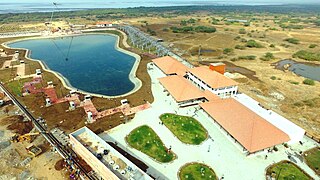
Dandi is a village in the Jalalpore taluka, Navsari District, Gujarat, India.

The Kurukh or Oraon, also spelt Uraon or Dhangad, are a Dravidian speaking ethnolinguistic group inhabiting Chhotanagpur Plateau and adjoining areas - mainly the Indian states of Jharkhand, Odisha, Chhattisgarh, and West Bengal. They predominantly speak Kurukh as their native language, which belongs to the Dravidian language family. In Maharashtra, Oraon people are also known as Dhangad.

Abbas Tyabji was an Indian freedom fighter from Gujarat, and an associate of Mahatma Gandhi. He also served as the Chief Justice of Baroda State. His grandson is historian Irfan Habib.
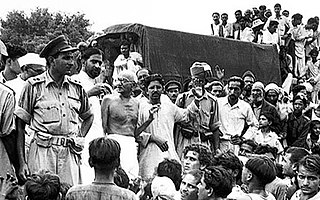
The Champaran Satyagraha of 1917 was the first satyagraha movement led by Mahatma Gandhi in British India and is considered a historically important rebellion in the Indian independence movement. It was a farmer's uprising that took place in Champaran district of Bihar in the Indian subcontinent, during the [British colonial period]. The farmers were protesting against having to grow indigo with barely any payment for it.
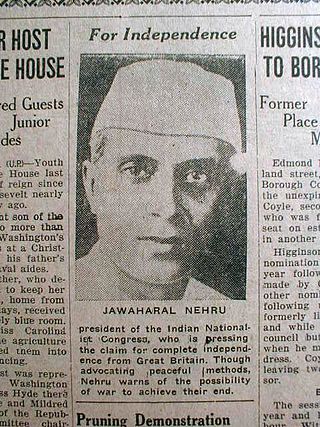
The Declaration of Purna Swaraj was a resolution which was passed in 1930 because of the dissatisfaction among the Indian masses regarding the British offer of Dominion status to India. The word Purna Swaraj was derived from Sanskrit पूर्ण (Pūrṇa) 'Complete' and स्वराज (Svarāja) 'Self-rule or Sovereignty', or Declaration of the Independence of India, it was promulgated by the Indian National Congress, resolving the Congress and Indian nationalists to fight for Purna Swaraj, or complete self-rule/total independence from the British rule.
In India, Flag Satyagraha is a campaign of peaceful civil disobedience during the Indian independence movement that focused on exercising the right and freedom to hoist the nationalist flag and challenge the legitimacy of the British Rule in India through the defiance of laws prohibiting the hoisting of nationalist flags and restricting civil freedoms. Flag Satyagrahas were conducted most notably in the city of Jabalpur and Nagpur in 1923 but also in many other parts of India.

The Quit India speech was given by Mahatma Gandhi on the eve of the Quit India Movement, 8 August 1942. His address was issued shortly before midnight, at the Gowalia Tank Maidan park in Bombay, which has since been renamed August Kranti Maidan.

Vaikom Satyagraha, from 30 March 1924 to 23 November 1925, was a nonviolent agitation for access to the prohibited public environs of the Vaikom Temple in the Kingdom of Travancore. Kingdom of Travancore was known for its rigid and oppressive caste system. The campaign was led by Congress leaders T. K. Madhavan, K. Kelappan, K. P. Kesava Menon. Other notable leaders who participated in the campaign include George Joseph, E. V. Ramasamy "Periyar" and it was noted for the active support and participation offered by different communities and a variety of activists.

Dukkipati Nageswara Rao was an Indian independence movement activist from Krishna District.

Tana Bhagats is a tribal community in Indian state of Jharkhand. They are related to the historical Tana Bhagat Movement (1914).

The Kheda Satyagraha of 1918 was a satyagraha movement in the Kheda district of Gujarat in India organised by Mahatma Gandhi during the period of the British Raj. It was a major revolt in the Indian independence movement. It was the second Satyagraha movement, which was launched 7 days after the Ahmedabad mill strike. After the successful Satyagraha conducted at Champaran in Bihar, Gandhi organised the movement to support peasants who were unable to pay the revenue because of famine and plague epidemic.
Pandit Neki Ram was an Indian politician. He was a Member of Parliament, representing Haryana in the Rajya Sabha the upper house of India's Parliament as a member of the Indian National Congress.
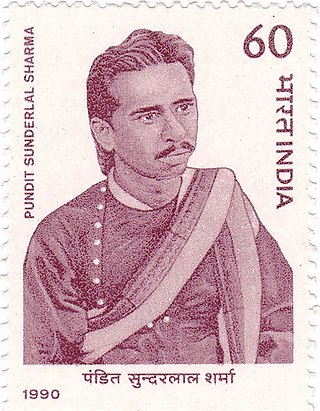
Pandit Sundarlal Sharma was a key figure in the independence movement from Chhattisgarh. He was largely responsible for ushering in political and social consciousness to Chhattisgarh. In 1920, he started the canal satyagraha, also known as the Nahar satyagraha, at a village called Kandel in Dhamtari Tehsil. Chhattisgarh has a university in the name of Pandit Sundarlal Sharma.
